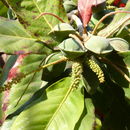en
names in breadcrumbs


Terminalia catappa is a large tropical tree in the leadwood tree family, Combretaceae, native to Asia, Australia, the Pacific, Madagascar and Seychelles.[1] Common names in English include country almond, Indian almond, Malabar almond, sea almond, tropical almond,[3] beach almond[4] and false kamani.[5]
The tree grows to 35 metres (115 feet) tall, with an upright, symmetrical crown and horizontal branches. The fruit is corky and light and dispersed by water. As the tree gets older, its crown becomes more flattened to form a spreading, vase shape. Its branches are distinctively arranged in tiers. The leaves are large, 15–25 cm (6–9+3⁄4 in) long and 10–14 cm (4–5+1⁄2 in) broad, ovoid, glossy dark green, and leathery. They are dry-season deciduous; before falling, they turn pinkish-reddish or yellow-brown, due to pigments such as violaxanthin, lutein, and zeaxanthin.
The trees are monoecious, with distinct male and female flowers on the same tree. Both are 1 cm (3⁄8 in) in diameter, white to greenish, and inconspicuous with no petals; they are produced on axillary or terminal spikes. The fruit is a drupe 5–7 cm (2–2+3⁄4 in) long and 3–5.5 cm (1+1⁄8–2+1⁄8 in) broad, green at first, then yellow and finally red when ripe, containing a single seed. Pollen grains measure about 30 microns.
The species epithet is based on its Malay name Ketapang.[6][7]
The tree has been spread widely by humans, so the native range is uncertain. It has long been naturalised in a broad belt extending from Africa to northern Australia and New Guinea through southeast Asia and Micronesia into the Indian subcontinent. More recently, the plant has been introduced to parts of the Americas. Until the mid-20th century, the tree had been used extensively in Brazilian urban landscaping, since being a rare case tropical deciduous, their fallen leaves would give a "European" flair to the street. This practice is currently abolished, and the "amendoeiras" are being replaced by native, evergreen trees.
T. catappa is widely grown in tropical regions of the world as an ornamental tree, grown for the deep shade its large leaves provide. The fruit is edible,[8] tasting slightly acidic. The seeds are edible raw or cooked[9] when ripe and the source of its 'almond' common names, but are small and difficult to extract.
The wood is red and solid, and has high water resistance; it has been used in Polynesia for making canoes. In Tamil, almond is known as nattuvadumai.
The leaves contain several flavonoids (such as kaempferol or quercetin), several tannins (such as punicalin, punicalagin or tercatin), saponines and phytosterols. Due to this chemical richness, the leaves (and the bark) are used in different herbal medicines for various purposes. For instance in Taiwan, fallen leaves are used as an herb to treat liver diseases. In Suriname, an herbal tea made from the leaves has been prescribed against dysentery and diarrhea. The leaves may contain agents for prevention of cancers (although they have no demonstrated anticarcinogenic properties) and antioxidants, as well as anticlastogenic characteristics. Extracts of T. catappa have shown activity against Plasmodium falciparum chloroquine (CQ)-resistant (FcB1) and CQ-sensitive (HB3) strains.[10]
Keeping the leaves in an aquarium may lower the pH and heavy-metal content of the water. It has been used in this way by fish breeders for many years, and is active against some parasites and bacterial pathogens.[11] It is also believed to help prevent fungus forming on the eggs of the fish.
Tree canopy on Sand Island, Midway Atoll
{{cite book}}: CS1 maint: others (link) Terminalia catappa is a large tropical tree in the leadwood tree family, Combretaceae, native to Asia, Australia, the Pacific, Madagascar and Seychelles. Common names in English include country almond, Indian almond, Malabar almond, sea almond, tropical almond, beach almond and false kamani.